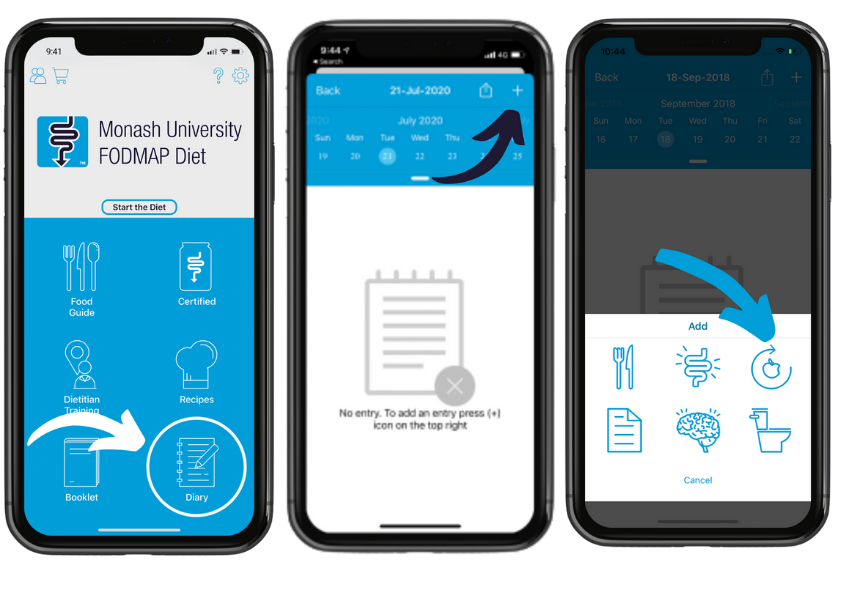
Some of our most frequently asked questions here at Monash FODMAP are around reintroduction. We understand this process can be challenging, and that’s why we introduced the ‘reintroduction’ setting in the diary function of your app. This blog is here to guide you through this process to ensure optimum results of step2 of the FODMAP diet.
If you have completed step 1 of the FODMAP diet (with guidance from your dietitian) and your symptoms are under control, you are now ready for step 2 – reintroduction. After clicking into the diary function (image on left) of your app, click the arrow in the top right corner (middle image), and you will enter the screen pictured below. Click the reintroduction button (image on right).

We suggest each FODMAP subgroup separately, over a ~3-day period, one challenge food at a time and stay on a low FODMAP diet as your ‘background’ diet. For best results, we recommend using foods that contain significant amounts of only one FODMAP at a time to challenge, for example, honey that contains fructose as its major FODMAP. The app will provide you with suggestions for suitable challenges foods for each FODMAP group.
This
all depends on your needs and usual diet – work with your dietitian to create a
reintroduction plan that works best for you. You might want to introduce a food
that you eat regularly first, so you can tick that off your list. Or you might
like to choose a food that you think will be tolerated well, as this will help
to build up your confidence for future challenges. Take our fructose example- if
you scroll through the suggested options and find that you only eat one of the
options listed (i.e. honey), then it makes sense to use this as a test food,
rather than asparagus.

It’s important to remember to use our app as a guide. On the image above, you can see that we have suggested an amber serve of 1.5 tsp for the first day and 2 tsp for the second day. If these serve sizes are too big, or too small compared to your usual serve of honey, then adjust it accordingly and personalise it to what you would usually eat. Start smaller and increase serve size incrementally across the 3 days. Use your diary to monitor your symptoms and if after the first or second day, you are experiencing unpleasant symptoms, stop. Unfortunately, learning about our thresholds may come with a little bit of pain. On the other hand, if you get through the 3 days without symptoms, or symptoms that are minor (remember, a little bit of wind and bloating is normal) and don’t impact your daily activities, then you have passed the challenge.
We often get asked about the serve size we have used in the reintroduction setting of the app. Take again for example, fructose. Honey and mango (see images below) are two high fructose foods, with very different concentrations of fructose. If you had a serving size of honey with the suggested size of mango, that might be problematic for even the toughest gut. It’s best to stick with one food during your reintroduction phase due to these different doses.
Fructans are a group where dose varies a lot between different food groups. To read more about fructans, read our blog: Fructans and FODMAP reintrodcution.
You may have noticed that our app suggests reintroducing foods with multiple FODMAPs. This is because these are common foods that are widely eaten and available, like pears and apples. We recommend leaving these reintroductions to last, because it is important that you understand your tolerance to individual FODMAPs first. In the example below, we have already established our thresholds for fructose and sorbitol seperately, but want to now learn about how we tolerate them together. Using the diary function in the app to monitor not just food intake, but your other symptoms related to IBS, including stress, will help you and your dietitian to unpack which foods may be triggers.

The reintroduction step of the diet can be complicated, we know this, but it also doesn’t need to be overcomplicated. Remember, the foods and doses suggested in the reintroduction setting of the app are a guide, not a rule book. Work with your dietitian to make a reintroduction plan that best suits you and your eating patterns. Once you have established your thresholds, be flexible and try to incorporate as much variety into your diet as possible!